Education and training for preventing sharps injuries and splash exposures in healthcare workers
- PMID: 33871067
- PMCID: PMC8094230
- DOI: 10.1002/14651858.CD012060.pub2
Education and training for preventing sharps injuries and splash exposures in healthcare workers
Abstract
Background: In healthcare settings, health care workers (HCWs) are at risk of acquiring infectious diseases through sharps injuries and splash exposures to blood or bodily fluids. Education and training interventions are widely used to protect workers' health and safety and to prevent sharps injuries. In certain countries, they are part of obligatory professional development for HCWs.
Objectives: To assess the effects of education and training interventions compared to no intervention or alternative interventions for preventing sharps injuries and splash exposures in HCWs.
Search methods: We searched CENTRAL, MEDLINE, Embase, NHSEED, Science Citation Index Expanded, CINAHL and OSH-update (from all time until February 2016). In addition, we searched the databases of Global Health, AustHealth and Web of Science (from all time until February 2016). The original search strategy was re-run in November 2019, and again in February 2020. In April 2020, the search strategy was updated and run in CINAHL, MEDLINE, Scopus and Web of Science (from 2016 to current).
Selection criteria: We considered randomized controlled trials (RCTs), cluster-randomized trials (cluster-RCTs), controlled clinical trials (CCTs), interrupted time series (ITS) study designs, and controlled before-and-after studies (CBA), that evaluated the effect of education and training interventions on the incidence of sharps injuries and splash exposures compared to no-intervention.
Data collection and analysis: Two authors (SC, HL) independently selected studies, and extracted data for the included studies. Studies were analyzed, risk of bias assessed (HL, JL) , and pooled using random-effect meta-analysis, where applicable, according to their design types. As primary outcome we looked for sharps injuries and splash exposures and calculated them as incidence of injuries per 1000 health care workers per year. For the quality of evidence we applied GRADE for the main outcomes.
Main results: Seven studies met our inclusion criteria: one cluster-RCT, three CCTs, and three ITS studies. The baseline rates of sharps injuries varied from 43 to 203 injuries per 1000 HCWs per year in studies with hospital registry systems. In questionnaire-based studies, the rates of sharps injuries were higher, from 1800 to 7000 injuries per 1000 HCWs per year. The majority of studies utilised a combination of education and training interventions, including interactive demonstrations, educational presentations, web-based information systems, and marketing tools which we found similar enough to be combined. In the only cluster-RCT (n=796) from a high-income country, the single session educational workshop decreased sharps injuries at 12 months follow-up, but this was not statistically significant either measured as registry-based reporting of injuries (RR 0.46, 95% CI 0.16 to 1.30, low-quality evidence) or as self-reported injuries (RR 0.41, 95% CI 0.14 to 1.21, very low-quality evidence) In three CCTs educational interventions decreased sharps injuries at two months follow-up (RR 0.68, 95% CI 0.48 to 0.95, 330 participants, very low-quality evidence). In the meta-analysis of two ITS studies with a similar injury rate, (N=2104), the injury rate decreased immediately post-intervention by 9.3 injuries per 1000 HCWs per year (95% CI -14.9 to -3.8). There was a small non-significant decrease in trend over time post-intervention of 2.3 injuries per 1000 HCWs per year (95% CI -12.4 to 7.8, low-quality evidence). One ITS study (n=255) had a seven-fold higher injury rate compared to the other two ITS studies and only three data points before and after the intervention. The study reported a change in injury rate of 77 injuries per 1000 HCWs (95% CI -117.2 to -37.1, very low-quality evidence) immediately after the intervention, and a decrease in trend post-intervention of 32.5 injuries per 1000 HCWs per year (95% CI -49.6 to -15.4, very low quality evidence). None of the studies allowed analyses of splash exposures separately from sharps injuries. None of the studies reported rates of blood-borne infections in patients or staff. There was very low-quality evidence of short-term positive changes in process outcomes such as knowledge in sharps injuries and behaviors related to injury prevention. AUTHORS' CONCLUSIONS: We found low- to very low-quality evidence that education and training interventions may cause small decreases in the incidence of sharps injuries two to twelve months after the intervention. There was very low-quality evidence that educational interventions may improve knowledge and behaviors related to sharps injuries in the short term but we are uncertain of this effect. Future studies should focus on developing valid measures of sharps injuries for reliable monitoring. Developing educational interventions in high-risk settings is another priority.
Copyright © 2021 The Cochrane Collaboration. Published by John Wiley & Sons, Ltd.
Conflict of interest statement
Shelley Cheetham: This work forms part of a Master of Philosophy (Research). This research was carried out while SC was in receipt of an Australian Government Research Training Fees Offset Scholarship at the University of Western Australia.
Juha Liira: None known
Helena Liira: None known
Hanh Ngo: None known
Figures
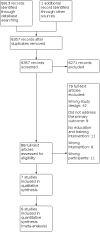


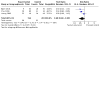
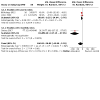
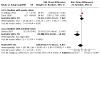

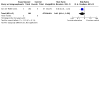

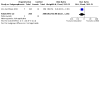


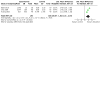



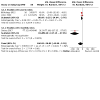
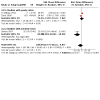
Update of
- doi: 10.1002/14651858.CD012060
References
References to studies included in this review
Bijani 2018 {published data only}
-
- Bijani M, Rostami K, Momennasab M, Yektatalab S. Evaluating the effectiveness of a continuing education program for prevention of occupational exposure to needle stick injuries in nursing staff based on Kirkpatrick's model. Journal of the National Medical Association 2018;110(5):459-63. - PubMed
Choi 2009 {published data only}
-
- Choi JS, Kim KS. Application and evaluation of a web-based education program on blood-borne infection control for nurses. Journal of Korean Academy of Nursing 2009;39(2):298-309. - PubMed
El Beltagy 2012 {published and unpublished data}
-
- El Beltagy K, El-Saed A, Sallah M, Balkhy HH. Impact of infection control educational activities on rates and frequencies of percutaneous injuries (PIs) at a tertiary care hospital in Saudi Arabia. Journal of Infection and Public Health 2012;5(4):297-303. - PubMed
Huang 2002 {published data only}
-
- Huang J, Jiang D, Wang X, Liu Y, Fennie K, Burgess J, et al. Changing knowledge, behaviour, and practice related to universal precautions among hospital nurses in China. Journal of Continuing Education in Nursing 2002;33(5):217-24. - PubMed
Sarbaz 2017 {published data only}
-
- Sarbaz M, Kimiafar K, Taherzadeh Z, Naderi HR, Eslami S. Effect of modifying the information and training structure on the occupational safety of health care workers in exposure to blood and body fluids: a quasi-experimental study. American Journal of Infection Control 2017;45(1):80-2. - PubMed
Van der Molen 2011 {published data only}
-
- Van der Molen HF, Zwinderman KAH, Sluiter J, Frings-Dresen MHW. Better effect of the use of a needle safety device in combination with an interactive workshop to prevent needle stick injuries. Safety Science 2011;49:1180-6.
Zafar 2009 {published data only}
References to studies excluded from this review
Abdo 2019 {published data only}
-
- Abdo NM, Hamza WS, Al-Fadhli MA. Effectiveness of education program on hospital waste management. International Journal of Workplace Health Management 2019;12(6):457-68.
Adams 2003 {published data only}
-
- Adams D, Elliott TSJ. A comparative user evaluation of three needle-protective devices. British Journal of Nursing 2003;12(8):470-4. - PubMed
Adams 2006 {published data only}
-
- Adams D, Elliott TSJ. Impact of safety needle devices on occupationally acquired needlestick injuries: a four year prospective study. Journal of Hospital Infection 2006;64(1):50-5. - PubMed
Ahmed Saleh 2017 {published data only}
-
- Ahmed Saleh AM, Adam SM, Ibrahim AMA, Morsy TA. A training program for nursing staff regarding blood parasites acquired by needle stick injury in a military hospital. Journal of the Egyptian Society of Parasitology 2017;47(1):65-80. - PubMed
Akbari 2018 {published data only}
Al Maqbali 2014 {published data only}
-
- Al Maqbali MA. Using double gloves in surgical procedures: a literature review. British Journal of Nursing 2014;23(21):1116-22. - PubMed
Al‐Zahrani 2014 {published data only}
-
- Al-Zahrani AO, Farahat F, Zolaly EN. Knowledge and practices of healthcare workers in relation to bloodborne pathogens in a tertiary care hospital, Western Saudi Arabia. Journal of Community Health 2014;39(5):959-64. - PubMed
Amira 2014 {published data only}
Amuwo 2011 {published data only}
-
- Amuwo S, Sokas RK, Nickels L, Zanoni J, Lipscomb J. Implementation and evaluation of interventions for home care aids on blood and body fluid exposure in large group settings. New Solutions 2011;21(2):235-50. - PubMed
Amuwo 2013 {published data only}
-
- Amuwo S, Lipscomb J, McPhaul K, Sokas RK. Reducing occupational risk for blood and body fluid exposure among home care aides: an intervention effectiveness study. Home Health Care Services Quarterly 2013;32(4):234-48. - PubMed
Apisarnthanarak 2008 {published data only}
-
- Apisarnthanarak A, Babock HM, Fraser VJ. The effect of nondevice interventions to reduce needlestick injuries among healthcare workers in a Thai tertiary care center. American Journal of Infection Control 2008;36(1):74-5. - PubMed
Ashat 2011 {published data only}
-
- Ashat M, Bhatia V, Puri S, Thakare M, Koushal V. Needle stick injury and HIV risk among health care workers in northern India. Indian Journal of Medical Sciences 2011;65(9):371-8. - PubMed
Askari 1989 {published data only}
-
- Askari E, Alexander DL. AIDS and the minority health care worker. Workplace Health & Safety Journal 1989;37(3):109-13. - PubMed
Askarian 2006 {published data only}
-
- Askarian M, Malekmakan L. The prevalence of needle stick injuries in medical, dental, nursing and midwifery students at the university teaching hospitals of Shiraz, Iran. Indian Journal of Medical Sciences 2006;60(6):227-32. - PubMed
Askarian 2011 {published data only}
-
- Askarian M, Yadollahi M, Kouchak F, Danaei M, Vakili V, Momeni M. Precautions for health care workers to avoid hepatitis B and C virus infection. International Journal of Occupational and Environmental Medicine 2011;2(4):191-8. - PubMed
Azar‐Cavanagh 2007 {published data only}
-
- Azar-Cavanagh M, Burdt P, Green-McKenzie J. Effect of the introduction of an engineered sharps injury prevention device on the percutaneous injury rate in healthcare workers. Infection Control and Hospital Epidemiology 2007;28(2):165-9. - PubMed
Aziz 2009 {published data only}
-
- Aziz AM, Ashton H, Pagett A, Mathieson K, Jones S, Mullin B. Sharps management in hospital: an audit of equipment, practice and awareness. British Journal of Nursing 2009;18(2):92-8. - PubMed
Aziz 2018 {published data only}
-
- Aziz AM. Do training and needle-safety devices prevent needlestick injuries? A systematised review of the literature. British Journal of Nursing 2018;27(16):944-52. - PubMed
Beekmann 2001 {published data only}
-
- Beekmann SE, Vaughn TE, McCoy KD, Ferguson KJ, Torner JC, Woolson RF, et al. Hospital bloodborne pathogens programs: program characteristics and blood and body fluid exposure rates. Infection Control and Hospital Epidemiology 2001;22(2):73-82. - PubMed
Bodkin 2003 {published data only}
-
- Bodkin C, Bruce J. Health professionals' knowledge of prevention strategies and protocol following percutaneous injury. Curationis 2003;26(4):22-8. - PubMed
Brusaferro 2009 {published data only}
-
- Brusaferro S, Calligaris L, Farneti F, Gubian F, Londero C, Baldo V. Educational programmes and sharps injuries in health care workers. Occupational Medicine 2009;59(7):512-4. - PubMed
Calabro 1998 {published data only}
-
- Calabro K, Weltge A, Parnell S, Kouzekanani K, Ramirez E. Intervention for medical students: effective infection control. American Journal of Infection Control 1998;26(4):431-6. - PubMed
Cantineau 2002 {published data only}
-
- Cantineau A, Brauer G, Deiss V, Guillet N, Hecht MT. Blood exposure accident prevention and education-action. Soins 2002;(671):42-4. - PubMed
Chin 2001 {published data only}
-
- Chin RL, Tabas JA, Neighbor ML. A teaching module to prevent needle sticks and exposures to body fluid. Academic Medicine 2001;76(5):529-30. - PubMed
Dante 2014 {published data only}
-
- Dante A, Natolini M, Graceffa G, Zanini A, Palese A. The effects of mandatory preclinical education on exposure to injuries as reported by Italian nursing students: a 15-year case-control, multicentre study. Journal of Clinical Nursing 2014;23(5-6):900-4. - PubMed
Duerink 2006 {published data only}
-
- Duerink DO, Farida H, Nagelkerke NJD, Wahyono H, Keuter M, Lestari ES, et al, Antimicrobial Resistance in Indonesia: Prevalence and Prevention Study Group. Preventing nosocomial infections: improving compliance with standard precautions in an Indonesian teaching hospital. Journal of Hospital Infection 2006;64(1):36-43. - PubMed
Enwere 2014 {published data only}
Fathi 2017 {published data only}
Fritzsche 2016 {published data only}
-
- Fritzsche C, Heine M, Loebermann M, Klammt S, Podbielski A, Mittlmeier T, et al. Reducing the underreporting of percutaneous exposure incidents: a single-center experience. American Journal of Infection Control 2016;44(8):941-3. - PubMed
Froom 1998 {published data only}
-
- Froom P, Kristal-Boneh E, Melamed S, Shalom A, Ribak J. Prevention of needle-stick injury by the scooping-resheathing method. American Journal of Industrial Medicine 1998;34(1):15-9. - PubMed
Fukuda 2016 {published data only}
-
- Fukuda H, Yamanaka N. Reducing needlestick injuries through safety-engineered devices: results of a Japanese multi-centre study. Journal of Hospital Infection 2016;92(2):147-53. - PubMed
Gershon 1999 {published data only}
-
- Gershon RRM, Pearse L, Grimes M, Flanagan PA, Vlahov D. The impact of multifocused interventions on sharps injury rates at an acute-care hospital. Infection Control and Hospital Epidemiology 1999;20(12):806-11. - PubMed
Gramling 2013 {published data only}
-
- Gramling JJ, Nachreiner N. Implementing a sharps injury reduction program at a charity hospital in India. Workplace Health & Safety 2013;61(8):339-45. - PubMed
Hagstrom 2006 {published data only}
-
- Hagstrom AM. Perceived barriers to implementation of a successful sharps safety program. Association of Operating Room Nurses Journal 2006;83(2):391-7. - PubMed
Haiduven 1992 {published data only}
-
- Haiduven DJ, DeMaio TM, Stevens DA. A five year study of needlestick injuries: significant reduction associated with communication, education, and convenient placement of sharps containers. Infection Control and Hospital Epidemiology 1992;13(5):265-71. - PubMed
Haiduven 1995 {published data only}
-
- Haiduven DJ, Phillips ES, Clemons KV, Stevens DA. Percutaneous injury analysis: consistent categorization, effective reduction methods, and future strategies. Infection Control and Hospital Epidemiology 1995;16(10):582-9. - PubMed
Higginson 2013 {published data only}
-
- Higginson R, Parry A. Needlestick injuries and safety syringes: a review of the literature. British Journal of Nursing 2013;22(8):4-12. - PubMed
Hiko 2012 {published data only}
-
- Hiko D, Jemal A, Sudhakar M, Kerie MW, Degene T. Effectiveness of training on standard precautions to prevent needle stick injuries among health professionals: a systematic review. Joanna Briggs Institute Library of Systematic Reviews 2012;10(14):1-13. - PubMed
Holodnick 2000 {published data only}
-
- Holodnick CL, Barkauskas V. Reducing percutaneous injuries in the OR by educational methods. Association of Operating Room Nurses Journal 2000;72(3):461-76. - PubMed
Hooper 2005 {published data only}
-
- Hooper J, Charney W. Creation of a safety culture. American Association of Occupational Health Nurses Journal 2005;53(9):394-8. - PubMed
Hunt 2004 {published data only}
-
- Hunt J, Murphy C. Measurement of nursing staff occupational exposures in the operating suite following introduction of a prevention programme. Australian Infection Control 2004;9(2):57-63.
Kanamori 2016 {published data only}
-
- Kanamori H, Weber DJ, Dibiase LM, Pitman KL, Consoli SA, Hill J, et al. Impact of safety-engineered devices on the incidence of occupational blood and body fluid exposures among healthcare personnel in an academic facility, 2000-2014. Infection Control and Hospital Epidemiology 2016;37(5):497-505. - PubMed
Krishnan 2007 {published data only}
-
- Krishnan P, Dick F, Murphy E. The impact of educational interventions on primary health care workers' knowledge of occupational exposure to blood or body fluids. Occupational Medicine 2007;57(2):98-103. - PubMed
Linnemann 1991 {published data only}
-
- Linnemann CC, Cannon C, DeRonde M, Lanphear B. Effect of educational programs, rigid sharps containers, and universal precautions on reported needlestick injuries in healthcare workers. Infection Control and Hospital Epidemiology 1991;12(4):214-9. - PubMed
Louis 2002 {published data only}
-
- Louis N, Vella G. Evaluation of a prevention measure against blood exposure accidents. Soins 2002;(671):45-6. - PubMed
Lueveswanji 2000 {published data only}
-
- Lueveswanji S, Nittayananta W, Robison VA. Changing knowledge, attitudes, and practices of Thai oral health personnel with regard to AIDS: an evaluation of an educational intervention. Community Dental Health 2000;17(3):165-71. - PubMed
Marziale 2010 {published data only}
-
- Marziale MH, Zapparoli Ados S, Felli VE, Anabuki MH. Network prevention of accidents at work: a strategy for distance education. Brazilian Journal of Nursing 2010;63(2):250-6. - PubMed
Mendelson 2003 {published data only}
-
- Mendelson MH, Lin-Chen BY, Solomon R, Bailey E, Kogan G, Goldbold J. Evaluation of a safety resheathable winged steel needle for prevention of percutaneous injuries associated with intravascular-access procedures among healthcare workers. Infection Control and Hospital Epidemiology 2003;24(2):105-12. - PubMed
Mobasherizadeh 2005 {published data only}
-
- Mobasherizadeh S, Abne-Shahidi SA, Mohammadi NA, Abazari F. Intervention study of needle stick injury in Iran. Saudi Medical Journal 2005;26(8):1225-7. - PubMed
Moens 2004 {published data only}
-
- Moens G, Mylle G, Johannik K, Van Hoof R, Helsen G. Analysing and interpreting routinely collected data on sharps injuries in assessing preventative actions. Occupational Medicine 2004;54(4):245-9. - PubMed
Nour‐Eldein 2016 {published data only}
-
- Nour-Eldein H, Mohamed RA. Effect of education intervention on prevention of bloodborne infections for health care workers in family medicine centers, Suez Canal University in Ismailia City, Egypt. Middle East Journal of Family Medicine 2016;14(2):4-13.
Qaiser 2013 {published data only}
-
- Qaiser S, Arif A, Quaid S, Ahsan T, Riaz K, Niaz S, et al. Innovative solution to sharp waste management in a tertiary care hospital in Karachi, Pakistan. Infection Control and Hospital Epidemiology 2013;34(12):1297-1305. - PubMed
Rajkumari 2015 {published data only}
Regez 2002 {published data only}
-
- Regez RM, Rietra PJ, Van der Linden CT, Frissen PH, Weigel HM, Brinkman K. Reducing the risk of blood-transmitted infections of HIV, hepatitis B or C virus in a teaching hospital in Amsterdam - evaluation of a protocol for needlestick accidents among hospital staff during the period 1997-2001. Dutch Journal of Medicine 2002;146(13):617-21. - PubMed
Ribner 1990 {published data only}
-
- Ribner BS, Ribner BS. An effective educational program to reduce the frequency of needle recapping. Infection Control and Hospital Epidemiology 1990;11(12):635-8. - PubMed
Richard 2001 {published data only}
-
- Richard VS, Kenneth J, Ramaprabha P, Kirupakaran H, Chandy GM. Impact of introduction of sharps containers and of education programmes on the pattern of needle stick injuries in a tertiary care centre in India. Journal of Hospital Infection 2001;47(2):163-5. - PubMed
Rogers 2000 {published data only}
-
- Rogers B, Goodno L. Evaluation of interventions to prevent needlestick injuries in health care occupations. American Journal of Preventive Medicine 2000;18(4):90-8. - PubMed
Roudot‐Thoraval 1999 {published data only}
-
- Roudot-Thoraval F, Montagne O, Schaeffer A, Dubreuil-Lemaire M-L, Hachard D, Durand-Zaleski I. Costs and benefits of measures to prevent needlestick injuries in a university hospital. Infection Control and Hospital Epidemiology 1999;20(9):614-7. - PubMed
Sellick 1991 {published data only}
-
- Sellick JA, Hazamy PA, Mylotte JM. Influence of an educational program and mechanical opening needle disposal boxes on occupational needlestick injuries. Infection Control and Hospital Epidemiology 1991;12(12):725-31. - PubMed
Seng 2013 {published data only}
-
- Seng M, Lim JW, Sng J, Kong WY, Koh D. Incidence of needlestick injuries among medical students after implementation of preventive training. Singapore Medical Journal 2013;54(9):496-500. - PubMed
Sossai 2010 {published data only}
-
- Sossai D, Puro V, Chiappatoli L, Dagnino G, Odone B, Polimeri A, et al. Using an intravenous catheter system to prevent needlestick injury. Nursing Standard 2010;24(29):42-6. - PubMed
Srikrajang 2005 {published data only}
-
- Srikrajang J, Pochamarn C, Chittreecheur J, Apisarnthanarak A, Danchaivijitr S. Effectiveness of education and problem solving work group on nursing practices to prevent needlestick and sharp injury. Journal of the Medical Association of Thailand 2005;88(10):115-9. - PubMed
Stringer 2009 {published data only}
Tarigan 2015 {published data only}
-
- Tarigan LH, Cifuentes M, Quinn M, Kriebel D. Prevention of needle-stick injuries in healthcare facilities: a meta-analysis. Infection Control and Hospital Epidemiology 2015;36(7):823-9. - PubMed
Trape‐Cardoso 2004 {published data only}
-
- Trape-Cardoso M, Schenck P. Reducing percutaneous injuries at an academic health center: a five year review. American Journal of Infection Control 2004;32(5):301-5. - PubMed
Tuma 2006 {published data only}
-
- Tuma S, Sepkowitz KA. Efficacy of safety-engineered device implementation in the prevention of percutaneous injuries: a review of published studies. Clinical Infectious Diseases 2006;42(8):1159-70. - PubMed
Valls 2007 {published data only}
-
- Valls V, Lozano S Yanez R, Martinez MJ, Pascual F, Lloret J, et al. Use of safety devices and the prevention of percutaneous injuries among healthcare workers. Infection Control and Hospital Epidemiology 2007;28(12):1352-60. - PubMed
Visser 2006 {published data only}
-
- Visser L. Toronto hospital reduces sharps injuries by 80%, eliminates blood collection injuries. Healthcare Quarterly 2006;9(1):68-70. - PubMed
Wang 2003 {published data only}
-
- Wang H, Fennie K, He G, Burgess J, Williams AB. A training programme for prevention of occupational exposure to bloodborne pathogens: impact on knowledge, behaviour and incidence of needle stick injuries among student nurses in Changsha, People's Republic of China. Journal of Advanced Nursing 2003;41(2):187-94. - PubMed
Whitby 1991 {published data only}
-
- Whitby M, Stead P, Najman JM. Needlestick injury: impact of a recapping device and an associated education program. Infection Control and Hospital Epidemiology 1991;12(4):220-5. - PubMed
Whitby 2002 {published data only}
-
- Whitby RM, McLaws M-L. Hollow-bore needlestick injuries in a tertiary teaching hospital: epidemiology, education and engineering. Medical Journal of Australia 2002;177(8):418-22. - PubMed
Wright 1997 {published data only}
-
- Wright BJ, Turner JG, Daffin P. Effectiveness of computer-assisted instruction in increasing the rate of universal precautions-related behaviours. American Journal of Infection Control 1997;25(5):426-9. - PubMed
Wu 2020 {published data only}
Yang 2007 {published data only}
-
- Yang YH, Liou SH, Chen CJ, Yang CY, Wang CL, Chen CY, et al. The effectiveness of a training program on reducing needlestick injuries/sharp object injuries among soon graduate vocational nursing school students in southern Taiwan. Journal of Occupational Health 2007;49(5):424-9. - PubMed
Yang 2011 {published data only}
Zafar 1997 {published data only}
-
- Zafar AB, Butler RC, Podgorny JM, Mennonna PA, Gaydos LA, Sandiford JA. Effect of a comprehensive program to reduce needlestick injuries. Infection Control and Hospital Epidemiology 1997;18(10):712-5. - PubMed
Zawilla 2013 {published data only}
-
- Zawilla NH, Ahmed D. Sharps injuries among health care workers in Cairo university hospitals. International Journal of Risk & Safety in Medicine 2013;25(2):79-92. - PubMed
Zhang 2010 {published data only}
-
- Zhang Z, Yamamoto T, Wu XN, Moji K, Cai GX, Kuroiwa C. Educational intervention for preventing bloodborne infection among medical students in China. Journal of Hospital Infection 2010;75(1):47-51. - PubMed
Zhang 2013 {published data only}
-
- Zhang YT, Wang LS. Protection education towards needle stick injuries among nursing students in China: a meta-analysis. Chinese Journal of Evidence-Based Medicine 2013;13(6):754-9.
Additional references
Akduman 1999
-
- Akduman D, Kim LE, Parks RL, L'Ecuyer PB, Mutha S, Jeffe DB, et al. Use of personal protective equipment and operating room behaviours in four surgical subspecialties: personal protective equipment and behaviours in surgery. Infection Control and Hospital Epidemiology 1999;20(2):110-4. - PubMed
Ansa 2002
-
- Ansa VO, Udoma EJ, Umoh MS, Anah MU. Occupational risk of infection by human immunodeficiency and hepatitis B viruses among health workers in south-eastern Nigeria. East African Medical Journal 2002;79(5):254-6. - PubMed
Borenstein 2010
Burke 2006
CDC 2008
-
- Centers for Disease Control and Prevention. Workbook for designing, implementing & evaluating a sharps injury prevention program. Centers for Disease Control and Prevention, 2008. www.cdc.gov/sharpssafety/pdf/sharpsworkbook_2008.pdf (accessed prior to 3 March 2021).
Clarke 2002
-
- Clarke SP, Rockett JL, Sloane DM, Aiken LH. Organizational climate, staffing, and safety equipment as predictors of needlestick injuries and near-misses in hospital nurses. American Journal of Infection Control 2002;30(4):207-16. - PubMed
Covidence [Computer program]
-
- Veritas Health Innovation Covidence systematic review software. Version accessed 14 January 2016. Melbourne, Victoria: Veritas Health Innovation. Available at www.covidence.org.
Doebbeling 2003
-
- Doebbeling BN, Vaughn TE, McCoy KD, Beekmann SE, Woolson RF, Ferguson KJ, et al. Percutaneous injury, blood exposure, and adherence to standard precautions: are hospital-based health care providers still at risk? Clinical Infectious Diseases 2003;37(8):1006-13. - PubMed
Downs 1998
Ellenbecker 1996
-
- Ellenbecker MJ. Engineering controls as an intervention to reduce worker exposure. American Journal of Industrial Medicine 1996;29(4):303-7. - PubMed
EPOC 2013
-
- Cochrane Effective Practice and Organisation of Care Group. Interrupted time series (ITS) analyses [Interrupted time series (ITS) analyses]. https://epoc.cochrane.org/ (accessed 16 May 2016). [https://epoc.cochrane.org/sites/epoc.cochrane.org/files/uploads/21%20Int...]
Fisman 2002
-
- Fisman DN, Mittleman AM, Sorock GS, Harris AD. Willingness to pay to avoid sharps-related injuries: a study in injured health care workers. American Journal of Infection Control 2002;30(5):283-7. - PubMed
Fisman 2007
-
- Fisman DN, Harris AD, Rubin M, Sorock GS, Mittleman AM. Fatigue increases the risk of injury from sharps devices in medical trainees: results from a case-crossover study. Infection Control and Hospital Epidemiology 2007;28(1):10-7. - PubMed
GRADEproGDT 2015 [Computer program]
-
- McMaster University (developed by Evidence Prime) GRADEpro GDT. Version accessed prior to 2 March 2021. Hamilton (ON): McMaster University (developed by Evidence Prime), 2015. Available at gradepro.org.
Higgins 2011
-
- Higgins JPT, Green S (editors). Cochrane Handbook for Systematic Reviews of Interventions Version 5.1 [updated March 2011]. The Cochrane Collaboration, 2011. Available from training.cochrane.org/handbook/archive/v5.1.
Ilhan 2006
-
- Ilhan MN, Durukan E, Aras E, Turkcuoglu S, Aygun R. Long working hours increase the risk of sharp and needlestick injury in nurses: the need for new policy implication. Journal of Advanced Nursing 2006;56(5):563-8. - PubMed
Lavoie 2014
Mischke 2014
-
- Mischke C, Verbeek JH, Saarto A, Lavoie MC, Pahwa M, Ijaz S. Gloves, extra gloves or special types of gloves for preventing percutaneous exposure injuries in healthcare personnel. Cochrane Database of Systematic Reviews 2014, Issue 3. Art. No: CD009573. [DOI: 10.1002/14651858.CD009573.pub2] - DOI - PMC - PubMed
NHMRC 2010
-
- National Health and Medical Research Council. Australian guidelines for the prevention and control of infection in healthcare. Australian Government, Australian Commission on Safety & Quality in Healthcare, 2010. www.nhmrc.gov.au (accessed prior to 2 March 2021).
Noe 2005
-
- Noe RA. Employee training and development. In: Employee Training and Development. 3rd edition. Boston (MA): McGraw-Hill, 2005:184-90.
Oh 2005
-
- Oh HS, Yi SE, Choe KW. Epidemiological characteristics of occupational blood exposures of healthcare workers in a university hospital in South Korea for 10 years. Journal of Hospital Infection 2005;60(3):269-75. - PubMed
Orji 2002
-
- Orji EO, Fasubaa OB, Onwudiegwu U, Dare FO, Ogunniyi SO. Occupational health hazards among health care workers in an obstetrics and gynaecology unit of a Nigerian teaching hospital. Journal of Obstetrics and Gynaecology 2002;22(1):75-8. - PubMed
Parantainen 2011
Pruss‐Ustun 2005
-
- Pruss-Ustun A, Rapiti E, Hutin Y. Estimation of the global burden of disease attributable to contaminated sharps injuries among health-care workers. American Journal of Industrial Medicine 2005;48(6):482-90. - PubMed
Ramsay 2003
-
- Ramsay CR, Matowe L, Grilli R, Grimshaw JM, Thomas RE. Interrupted time series designs in health technology assessment: lessons from two systematic reviews of behavior change strategies. International Journal of Technology Assessment in Health Care 2003;19(4):613-23. - PubMed
Reddy 2017
-
- Reddy VK, Lavoie MC, Verbeek JH, Pahwa M. Devices for preventing percutaneous exposure injuries caused by needles in healthcare personnel [Devices for preventing percutaneous exposure injuries caused by needles in healthcare personnel]. Cochrane Database of Systematic Reviews 2017, Issue 11. Art. No: CD009740. [DOI: 10.1002/14651858.CD009740.pub3] - DOI - PMC - PubMed
RevMan 2014 [Computer program]
-
- Nordic Cochrane Centre, The Cochrane Collaboration Review Manager (RevMan). Version accessed prior to 2 March 2021. Copenhagen: Nordic Cochrane Centre, The Cochrane Collaboration, 2014.
Roberts 1999
-
- Roberts RB, Lincoff AS, Frankel RE. Occupational exposure to HIV in an urban university hospital setting. Brazilian Journal of Infectious Diseases 1999;3(2):50-62. - PubMed
Robinson 2002
-
- Robinson KA, Dickersin K. Development of a highly sensitive search strategy for the retrieval of reports of controlled trails using PubMed. International Journal of Epidemiology 2002;31(1):150-3. - PubMed
Robson 2010
-
- Robson L, Stephenson C, Schulte P, Amick B, Chan S, Bielecky A, et al. A Systematic Review of the Effectiveness of Training & Education for the Protection of Workers. Toronto: Institute for Work & Health; National Institute for Occupational Safety and Health, 2010.
Roelofs 2003
-
- Roelofs CR, Barbeau EM, Ellenbecker MJ, Moure-Eraso R. Prevention strategies in industrial hygiene: a critical literature review. American Industrial Hygiene Association Journal 2003;64(1):62-7. - PubMed
SAS 2013 [Computer program]
-
- SAS Institute Inc Statistical Analysis System (SAS). SAS Institute Inc, Version accessed prior to 2 March 2021. Cary, NC. USA: SAS Institute Inc, 2013. Available at www.sas.com.
Smith 2006a
-
- Smith DR, Choe MA, Jeong JS, Jeon MY, Chae YR, An GJ. Epidemiology of needlestick and sharps injuries among professional Korean nurses. Journal of Professional Nursing 2006;22(6):359-66. - PubMed
Smith 2006b
-
- Smith DR, Mihashi M, Adachi Y, Nakashima Y, Ishitake T. Epidemiology of needlestick and sharps injuries among nurses in a Japanese teaching hospital. Journal of Hospital Infection 2006;64(1):44-9. - PubMed
Sohn 2006
-
- Sohn JW, Kim BG, Kim SH, Han C. Mental health of healthcare workers who experience needlestick and sharps injuries. Journal of Occupational Health 2006;48(6):474-9. - PubMed
Verbeek 2004
-
- Verbeek J, Husman K, Van Dijk F, Jauhiainen M, Pasternack I, Vainio H. Building an evidence base for occupational health interventions. Scandinavian Journal of Work Environment and Health 2004;30(2):164-8. - PubMed
Verbeek 2005
Verbeek 2019
-
- Verbeek J, Basnet P. Incidence of sharps injuries in surgical units, a meta-analysis and meta-regression. American Journal of Infection Control 2019;47(4):448-55. - PubMed
Publication types
MeSH terms
LinkOut - more resources
Full Text Sources
Other Literature Sources
Medical
Research Materials
Miscellaneous

